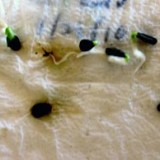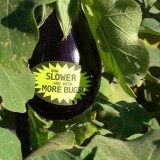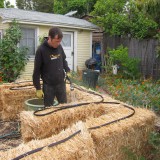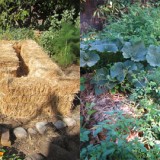
Consider this research as one more nail in the coffin of tilling and double digging. Scientists at UC Davis took a look at how no-till practices combined with cover crops foster a diverse fungi community that “play important roles in nutrient mobilization, organic matter decomposition, carbon cycling and creation of soil structure.” While their research looked at commercial agriculture I think it’s safe to extrapolate their results to home vegetable gardens. The latest issue of California Agriculture sums up the study,
Symbiotrophic fungi expand the surface area of roots, allowing roots greater access to water and nutrients (in exchange for carbon). Fungi, however, are more sensitive than other microorganisms to physical disturbance. Adopting no-till as a conservation management practice eliminates or greatly reduces both disruption of fungal hyphal networks and redistribution of organisms and nutrients in the soil profile. Use of cover crops, meanwhile, provides more abundant and varied sources of organic carbon.
Let me just add that we really regret promoting double-digging in one of our books! The science it pretty clear about the benefits of the relationship between fungi and roots and the damage that tilling can cause to plant/fungi cooperation.
The complete study, “Cover cropping and no-till increase diversity and symbiotroph:saprotroph ratios of soil fungal communities” (behind a pay wall) can be found here.
Support Root Simple
Handcrafted Modern: At Home with Mid-century Designers. An intimate and revealing collection of photographs of astonishingly beautiful, iconic, and undiscovered mid-century interiors. Among significant mid-century interiors, none are more celebrated yet underpublished as the homes created by architects and interior designers for themselves. This collection of newly commissioned photographs presents the most compelling homes by influential mid-century designers, such as Russel Wright, George Nakashima, Harry Bertoia, Charles and Ray Eames, and Eva Zeisel, among others.






Pingback: Stop Digging! The Benefits of No-Till and Cover Crops – 6/7/19 – Trusted News Feeds 2.0
I think you will find you weren’t the only one promoting double digging. I have lots of older greeny books that give it more than a passing mentionClaire in Melbourne, Australia
It’s been promoted heavily by John Jeavons who wrote a very popular vegetable gardening book, still in print, that was first published in 1974. He got the idea from Alan Chadwick who got it from French intensive gardening methods of the late 19th century.
When we know better, we do better. Head up, eyes open, always learning 🙂